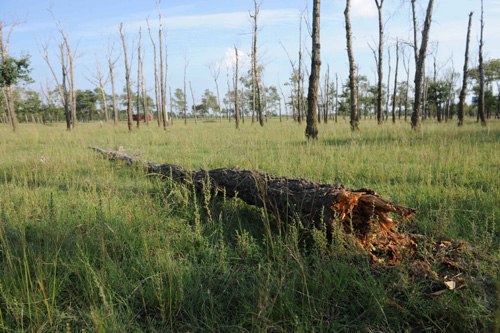However, such promising reductions in sandstorms affecting and sourced from Bashang could be undercut by the large-scale death of poplar trees in counties with manmade forests. Wang told Beijing-based Legal Evening News that most of Bashang's poplar forests were planted in the 1960s and 1970s and around 30 percent of them are dying or dead at this time. Forestry experts have identified dwindling underground water resources and trees' natural aging as the main causes.
Lu Mengzhu, a renowned poplar expert from the Research Institute of Forestry of the Chinese Academy of Forestry, told Beijing Review that poplar trees living in harsh environments will often die prematurely. He said that insect infestations used to be a major cause of death for poplar trees in north China until a team he headed successfully developed genetically insect-resistant poplars a few years ago.
Yuan began to notice the withering of poplars in large numbers back in 2003, the year she was elected a deputy to the National People's Congress (NPC), the country's top legislature.
|
 |
|
AGING AND DYING: A dead poplar lies rotting on the ground surrounded by a dying forest in Zhangbei county, Hebei province, on August 21. |
During her two five-year terms as a lawmaker, Yuan submitted motions at every annual NPC full session calling for subsidies to be granted to replace the dead trees in Bashang. Since her second term began in 2008, she started to hand in her proposals and advice to the Ministry of Finance and the National Development and Reform Commission (NDRC) as Bashang's forest update programs were being hindered by lack of funding. All four counties in Bashang are part of the national poverty reduction program and the local governments could not afford to replace all of the dead trees without support.
Yuan's calls have received attention in media outlets and attracted the attention of various government departments. In April, the Hebei Provincial Government launched a trial project for revitalizing 6.67 square km of poplar forests in Bashang: replacing dead trees with Scots pines and sea-buckthorns and replacing dying trees with their own branch cuttings. The provincial government paid 4 million yuan ($656,000) for the project while the remaining 6 million yuan ($984,000) was raised by local governments.
In early September, Wang told The Beijing News that the project showed promising results in Zhangbei as 95 percent of newly planted trees had survived and some poplar cuttings had grown to an average of 1 meter tall.
The NDRC has also conducted research so as to draw up a program to fund the replacement of trees in Bashang, which is scheduled to begin soon.
Large-scale undertaking
Poplar forests in Zhangbei are part of China's ambitious Three-North Shelterbelt Program, also known as the Green Great Wall, which is intended to slow the expansion of the country's northern deserts.
The program began in 1978 with the aim of increasing forest coverage from 5 to 15 percent across an area of 4.07 million square km. Once completed in 2050, the shelterbelt will measure 4,480 km from east to west, and will stretch 560 and 1,460 km from north to south at its narrowest and widest sections. Its total area will amount to 4.07 million square km, which equates to about 42.4 percent of China's total land area.
The program is creating windbreaks in 551 counties across 13 provinces, autonomous regions and municipalities in China's north, northwest and northeast. In the two decades before the initiation of the program, more than 4,000 square km of farmland in these regions was overtaken by deserts, while a further 8,670 square km suffered from reduced production due to sandstorms. Hundreds of reservoirs were also depleted and turned into desert over the period.
When the program is finished, it is estimated that it will directly benefit over 90 percent of the near half a million square km of the country's land whose desertification can be potentially curbed or reversed.
The latest data from the SFA showed that, as of the end of 2012, forest coverage in the treated areas had increased from the 5.05 percent in 1977 to 12.4 percent.
According to Xinhua News Agency, by the end of August this year, the Three-North Shelterbelt Program had successfully planted and cultivated forests totaling 267,000 square km.
The program launched its fifth, and the most recent, of eight planned phases, in 2012, which has three primary goals: creating another 100,000 square km of forests to boost local forest coverage to 12 percent by 2020; controlling the worsening desertification in 30 percent of at-risk farmland; and slowing or stopping topsoil erosion in half of the farmland at risk in the targeted areas.
